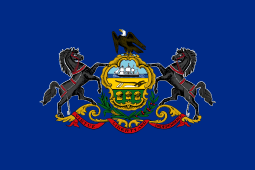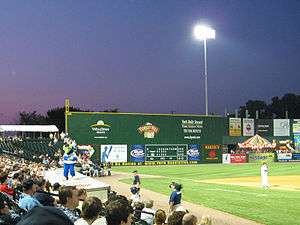Hershey Bears
The Hershey Bears are an American professional ice hockey team based in Hershey, Pennsylvania, a town located 14 miles east of the state capital of Harrisburg. The current Bears club has played in the American Hockey League since the 1938–39 season making it the longest continuously operating member club of the league still playing in its original city.[1][2][3]
| Hershey Bears | |
|---|---|
 | |
| City | Hershey, Pennsylvania |
| League | American Hockey League |
| Conference | Eastern |
| Division | Atlantic |
| Founded | 1932 (T-SHL/EAHL); 1938 (IAHL/AHL) |
| Home arena | Giant Center (2002–present) |
| Colors | Chocolate, tan, cocoa, white |
| Owner(s) | Hershey Bears Hockey Club, a sub-division of the Hershey Entertainment and Resorts Company |
| General manager | Bryan Helmer (VP of Hockey Operations) |
| Head coach | Spencer Carbery |
| Media | The Patriot-News WFVY WHTM-TV (ABC27) WHP-TV (CBS21) WGAL-TV (NBC8) WPMT-TV (FOX43) AHL.TV (Internet) |
| Affiliates | Washington Capitals (NHL) South Carolina Stingrays (ECHL) |
| Franchise history | |
| 1932–1933† | Hershey B'ars (T-SHL) |
| 1933–1934† | Hershey Chocolate B'ars (EAHL) |
| 1934–1936† | Hershey B'ars (EAHL) |
| 1936–1938† | Hershey Bears (EAHL) |
| 1938–1939† | Hershey Cubs (EAHL) |
| † —Non-AHL franchises operated by the Hershey Hockey Club | |
| 1938–present | Hershey Bears (IAHL, AHL) |
| Championships | |
| Regular season titles | 7 1942–43, 1957–58, 1980–81, 1985–86, 1987–88, 2006–07, 2009–10 |
| Division Championships | 17 1938–39, 1943–44, 1946–47, 1951–52, 1966–67, 1967–68, 1968–69, 1975–76, 1980–81, 1985–86, 1987–88, 1993–94, 2006–07, 2008–09, 2009–10, 2014-15, 2015-16 |
| Conference Championships | 23 1940–41, 1941–42, 1944–45, 1946–47, 1948–49, 1953–54, 1957–58, 1958–59, 1960–61, 1962–63, 1964–65, 1968–69, 1973–74, 1975–76, 1979–80, 1985–86, 1987–88, 1996–97, 2005–06, 2006–07, 2008–09, 2009–10, 2015-16 |
| Calder Cups | 11 1946–47, 1957–58, 1958–59, 1968–69, 1973–74, 1979–80, 1987–88, 1996–97, 2005–06, 2008–09, 2009–10 |
The Bears organization currently serves as the primary development club for the NHL's Washington Capitals since the 2005–06 season. Since the 2002–03 season the hockey club's home games have been played at Giant Center, located less than half a mile west of Hersheypark Arena, the AHL club's previous home from 1938 to 2002. (The Arena was also the home to the EAHL Hershey Bears from 1936 to 1938.) The Bears have won 11 Calder Cups, more than any other AHL team. They won their most recent title in 2010.
Chocolate manufacturer Milton S. Hershey first established the "Hershey Hockey Club" in 1932 to manage pro hockey teams based in Hershey. Now in its ninth decade, it has operated four teams in three pro leagues, including the AHL Bears. Now called the Hershey Bears Hockey Club, it is a subsidiary of the Hershey Entertainment and Resorts Company (originally called "Hershey Estates" and later "HERCO"), the entertainment and hospitality division of the Hershey Trust Company.[1][4]
Gordie Howe, who was selected into the Hockey Hall of Fame in 1972 and was known as "Mr. Hockey," once remarked, "Everybody who is anybody in hockey has played in Hershey," although he himself did not play there.[5]
Team history
The origins of "Hershey Hockey"
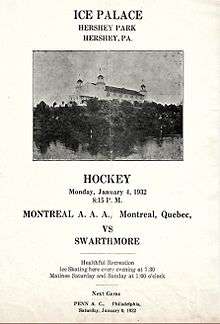
The history of Hershey hockey goes back to a series of amateur hockey matches played in Hershey between college teams beginning in early 1931. The first such formal hockey game ever played in Hershey took place on February 18, 1931, when Penn A.C. and Villanova University faced off in the 1,900-seat Hershey Ice Palace. Nine months after that successful inaugural contest, Swarthmore Athletic Club moved into the Ice Palace, where they played their first game on November 19, 1931, against Crescent A.C. of New York City. In the lineup that night for Crescent was a 23-year-old center named Lloyd S. Blinco, a native of Grand Mere, Quebec, who came to Hershey the next season and would remain continuously associated with Hershey hockey for a half century as a player, coach, and manager.[1][2]
The popularity of these amateur hockey matches prompted chocolate-maker and amusement park-operator Milton Hershey and his long-time entertainment and amusements chief, John B. Sollenberger, to bring pro hockey to Hershey by sponsoring a permanent team. To that end Mr. Hershey established the Hershey Hockey Club (now called the Hershey Bears Hockey Club) in 1932 which is now the oldest such continuously operating professional ice hockey management organization in North America outside of those operating the "Original Six" clubs of the National Hockey League in Montreal, Toronto, Boston, New York, Chicago, and Detroit, which were all established in or before 1926. The first hockey team the organization iced was the Hershey B'ars in the newly formed Tri-State Hockey League which included three other teams from Philadelphia, Baltimore, and Atlantic City. After a single season in 1932-33, that circuit reformed itself into a larger, seven-club Eastern Amateur Hockey League in which Hershey played first as the "Chocolate B'ars" (1933–1934), then again as the "B'ars" (1934–1936), and finally from 1936 to 1938 as the "Hershey Bears," a name adopted in response to criticism levied by New York sportswriters and the league that the "B'ars" moniker was too commercial. (These writers had already informally dubbed the club as the "Bears from Penn's Woods" when they visited Madison Square Garden to play the New York Rovers.)[1][2]
On December 19, 1936, the newly renamed EAHL Bears also moved from the confines of the Ice Palace (where they had to play on a small, 60x170-foot rink) into the newly constructed 7,286-seat Hersheypark Arena (then known as the "Hershey Sports Arena") built immediately adjacent to the older venue. Over the next sixty-six seasons, Bears' teams played a total of 2,280 EAHL and AHL regular season and playoff games at the Hersheypark Arena, which served as the home to hockey in Hershey from 1936 to 2002. Since 2002 the AHL Bears have used Hersheypark Arena as their practice arena only.[1][2]

The Bears join the IAHL
.jpg)
Since 1936, the Canadian–American Hockey League and International Hockey League had formed an eight-team "circuit of mutual convenience" playing an interlocking schedule as the International-American Hockey League.
On June 28, 1938, the Can-Am and IHL formally merged into a single league under the IAHL name. One of the first acts of the newly merged league, which became the American Hockey League in 1940, was to grant an expansion franchise to the Hershey Bears Hockey Club, which at the time still owned and operated the EAHL Hershey Bears, the then three-time regular season champions of that league. The new Bears took the Bisons' place in the IAHL's West Division, allowing the IAHL to play a balanced schedule for the first time in over two years. While the new Bears began play in the IAHL in 1938, the hockey club also continued to operate an EAHL team, the Hershey Cubs, for one more season before leaving that league altogether. In 1977 Hershey became the only original AHL hockey club to have continuously iced a team in the same city since the league's inaugural season as a fully merged league when the Rhode Island Reds franchise was sold and moved to New York state as the Binghamton Dusters after the 1976–77 campaign.[1]
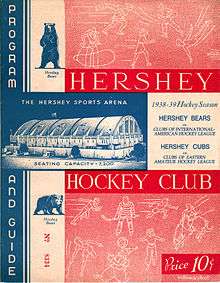
Defenseman Henry J. "Hank" Lauzon, an original EAHL B'ar, became the first player to sign with the new Bears. The former EAHL club's coach, Herb Mitchell, guided the IAHL Bears for their first three seasons. The Bears made a very good account of themselves in their first IAHL campaign, winning the West Division with a 31–18–5 record—the first of 16 regular-season division titles. However, they were defeated in the first round of the Calder Cup play-offs by the New York Rangers' top farm team, the Philadelphia Ramblers, three-games-to-two. Defenseman Herb Kalbfleisch became the first Hershey player to be named a First Team All Star that year while goalie Alfie Moore took Second Team honors behind the Ramblers' Bert Gardiner.[2][3]
Former Boston Bruins' coach and Hockey Hall of Fame member (elected 1971) Ralph "Cooney" Weiland guided Hershey throughout the war years winning regular season titles in 1942–43 and 1943–44.[3] The Bears' 13 losses in a 1942–43 are still the fewest by the club in a single season while Wally Kilrea's 99 points (31-68) that season gave Hershey its first of ten AHL scoring champions. Hershey won their first of 11 Calder Cup titles in 1947 under second year coach Don Penniston while also winning their fourth Division title in just nine seasons that year dominating the AHL's East with 84 points (25 more than second place Springfield) on a record of 36–16–12 behind All Star goalie Harvey Bennett, Sr. In the play offs Hershey defeated the Western Division champion Cleveland Barons in a four-game first round sweep outscoring them 24–3 before winning the Calder Cup finals in seven games over the Pittsburgh Hornets.[2][3]
In 1948, 21-year-old Winnipeg-born center Arnie Kullman joined the Bears, and except for 13 games with the Boston Bruins in 1949–50, he played his entire twelve-year career in Hershey. When Kullman retired in 1960 he had amassed 629 points on 253 goals and 376 assists in a Hershey uniform, a total which would only be eclipsed by Tim Tookey (with whom he shared number nine that was eventually retired in honor of both players) and Mike Nykoluk. Kullman's 753 games as a Bear is also second only to Nykoluk's 972.[3]
1950s–1960s
.jpg)
From 1950 to 1956 the Bears were coached by a pair of former Boston Bruin defensemen: Johnny Crawford (1950–52), who guided Hershey to another division title in 1951-52, followed by player-coach Murray Henderson (1952–56). In 1953-54, center George "Red" Sullivan became the second Bear to win a scoring title and the first to be named the league's MVP, collecting 119 points (30-89) in 69 games to set an AHL regular season scoring record which stood for almost thirty years, while his 89 assists that season is still an AHL record six decades later.[2][3]
Although never an All Star, another player to briefly skate in Hershey during this era was Don "Grapes" Cherry who as a coach (Rochester, Boston, Colorado) and later a broadcaster became and still remains one of the game's most visible and controversial figures. As a 20-year-old defenseman Cherry made his professional debut with the Bears during the 1954-55 season and also played for the club in 1956-57. As a TV personality and longtime commentator on Hockey Night in Canada, this former Bear is one of the best known figures in Canada in any field.[2]
With the demise of the AHL Pittsburgh Hornets in 1956, Bears managers John Sollenberger and Lloyd Blinco were able to acquire the services of seven of the recent Calder Cup champion Hornets' best players including four-time All Star goalie Gil Mayer and the AHL's eventual all-time scoring leader Willie Marshall (523–852—1,205).[3] The most important from Pittsburgh, however, was the AHL's only five-time First-Team All-Star defenseman, Frank S. Mathers, who remained active with the Bears for an unprecedented thirty-five seasons as an All Star defenseman, player-coach, general manager, and club president. Under Mathers' leadership, Hershey won over 1,500 games and six Calder Cup titles while Mathers himself was honored with the Lester Patrick Award in 1987 for his "contributions to hockey in the United States", and in 1992 he became the second individual to be elected to the Hockey Hall of Fame based on a career in the AHL.[2][3]
While the Mathers era in Hershey started slowly with a fourth-place finish in 1956-57, he led the Bears back-to-back Calder Cup titles in his second and third seasons as a player-coach. With Bobby Perreault and Mayer in goal, the league's top two scorers in linemates Marshall and Dunc Fisher, and Mathers himself earning All Star honors on defense for the sixth time in seven years, the Bears won both the regular season and play-off championships in 1957-58. Although Hershey finished the 1958-59 season with just a .500 record (32-32-6), they defeated the Cleveland Barons in the first round before upsetting the regular-season champion Buffalo Bisons in the finals, four-games-to-two, to win their third Calder Cup title.[2][3]

In 1958 the Bears also acquired the services of 23-year-old center Mike Nykoluk who had split the previous two seasons between the Toronto Maple Leafs and their AHL club in Rochester.[2] When Nykoluk retired fourteen years later in 1972, he was the AHL's then fourth (now sixth) all-time leader in points with 881 on 195 goals and 686 assists and his 972 games as a Bear are 219 more than Kullman's second overall 753 in a Hershey uniform.[3] In 1972 his jersey number eight also became the first to ever be retired by the Bears.[2]
Although it was more than a decade before the Calder Cup returned to Hershey, during the first half of the 1960s five key players joined the club who would each stay from anywhere from seven to nine seasons: defensemen Barry Ashbee (1962–70) and Ralph Keller (1963-72), and forwards Roger DeJordy (1962–70), Michel Harvey (1963-71) and Gil Gilbert (1965–72). Together they would eventually account for 2,654 games played, 710 goals, 1,251 assists, and 1,961 points as Bears.[2] While these five and league MVP Mike Nykoluk all helped the Bears win their division's regular-season title in 1966–67, for the first time since 1957-58, on a 38-24-10 record behind the goaltending of First Team All Star Andre Gill and a league-leading 52 goals by DeJordy, it would be another two years before the Calder Cup returned to Hershey in 1968-69 defeating the Quebec Aces in five games. Gilbert led the league in scoring with 100 points (35-65) with teammate Michel Harvey close behind at 93 as the Bears also won their third consecutive Eastern Divisional title. That season also saw Mathers add the duties of GM to his portfolio with the retirement of Lloyd Blinco from that post.[2][3]
1970s–1980s
With the close the 1972-73 season Frank Mathers ended his unbroken 17-year run as coach to devote his efforts full-time to his duties as GM. Including a brief return to the bench in 1984-85, Mathers compiled a personal coaching record of 610-513-134 for a career winning percentage of .539. His successor was former Bears' winger Chuck Hamilton (1973–79) who had spent seven seasons playing for Hershey from 1963 to 1970. In his first season as the Bears' coach Hamilton led a relatively inexperienced squad including nine rookies to a fifth Calder Cup title losing only two games in the playoffs' three rounds in which they the Cincinnati Swords (4-1), Baltimore Clippers (4-0), and Providence Reds (4-1) with the championship game played at the Arena before a then record crowd of 8,703.[2][3]
Hershey won a sixth Calder Cup in 1979-80 under player/coach Doug Gibson who replaced first year coach Gary Green when he was unexpectedly promoted to the Bears' then NHL affiliate, the Washington Capitals, early in the season. Gibson also led the Bears in play-off scoring with a dozen goals and seven assists for 19 points in sixteen Calder Cup games while goaltending was shared by Gary Inness (6-1) who himself would later coach the team and Dave Parro (6-3). Although Hershey had finished four games below .500 during the regular season (35-39-9), the Bears defeated the Syracuse Firebirds (4-0) in the opening round before upsetting both the Southern Division champion New Haven Nighthawks (4-2) in the semifinals and the Northern Division winning New Brunswick Hawks (4-2) in the finals with two of their four wins in the championship series in double overtime.[2][3]
Although the Bears did not repeat as Calder Cup champions in 1980-81, under new coach Bryan Murray the club had its best regular season to that point with 103 points on a record of 47-24-9 and established a still standing record for goals with 357. Right wing Mark Lofthouse become the fifth Bear to win the AHL's scoring title (48-55–103), and on the night of February 7, 1981 he also set a team single game record eight points (4-4) as the Bears defeated the Rochester Americans at Hersheypark Arena, 11-2, while the team also tied the AHL's then record for goals in a period with nine. Among the Bears' rookies that year was a 20-year-old center Tim Tookey, who over three separate stints with the Bears (1980–82, 1985–87, 1989–94) over the next fourteen years collected 693 points (251-442) in 529 regular season games, second only to Mike Nykoluk's 808 on the Bears' all-time list.[2][3]
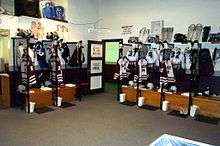
As had Gary Green in 1979, Murray left the Bears early in the 1981-82 season to become coach of the Washington Capitals (replacing Green) and was replaced by former Hershey goalie Gary Inness under most unusual circumstances. Inness had retired as a player a year earlier but wanted to remain in Hershey and keep involved with the Bears. With no coaching position available to offer him, but in need of a new trainer, Bears' GM Frank Mathers offered him that job. With Murray's promotion to Washington a month later elevated Inness the eleventh coach in the Bears' history. Inness would remain behind the Hershey bench until December, 1984, when Frank Mathers returned to that post on an interim basis for the first time since 1973 and coached the club until then recently retired Hall of Fame Flyer winger Bill Barber took over for the final sixteen games of the season.[2]
The 1984-85 season was also the first of a dozen year affiliation with the Philadelphia Flyers who shared the club with the Boston Bruins that year before taking over as the sole parent club the next season and remained so through 1995-96. Former Flyer right wing and AHL Hall of Fame coach John "Too Tall" Paddock (1985–89) took over for the next four seasons and under his guidance the Bears averaged 45 wins a year, won two overall regular season titles, reached the play-off finals twice, and brought Hershey a seventh Calder Cup championship in 1987-88.[2]
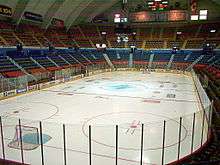
In his first year as the Bears' coach, Paddock led the club to first place overall in the regular season with a 48-29-3 record and either four goals in the final game of that 1985-86 season, left wing Ross Fitzpatrick became the third Bear to score 50 goals in a season while rookie goalie Ron Hextall, now GM of the Flyers, set a team record with three consecutive shutouts at home. Both Hextall and defenseman Kevin McCarthy were First Team All Stars while linemates Fitzpatrick and Tim Tookey were both named to the second All Star Team. With five shut-outs and a 30-19-2 record, Hextall became the first (and so far only) Bear to be named AHL Rookie of the Year as well as winning the Baz Bastien Memorial Trophy as the AHL's top goalie. (As an NHL rookie the following season with the Flyers Hextall won both the Vezina Trophy and Conn Smythe Trophy.) Although th Bears lost to the Adirondack Red Wings in the Calder Cup finals, Tookey also won the Jack Butterfield Trophy as MVP of the play-offs.)[2][3]
Although the Bears finished fourth in the Southern Division in 1986-87 with 87 points (43-36-1), their top line of Tookey, Fitzpatrick and Ray Allison finished first, fifth and seventh in overall league scoring with 124, 85 and 84 points respectively and accounted for a total of 125 of the Bears' 329 goals while center Mitch Lamoureux also finished in the top ten with 43 goals and 46 assists for 89 points good for fourth overall in the league. Tookey's 124 points (51 goals, 73 assists) also established a still standing single-season record for a Hershey player, made him the seventh Bear to win the AHL's scoring title, and just the third to win the Les Cunningham Plaque as the league's MVP. Tookey's 124 points that year is still the sixth best single-season total for an individual player in AHL history, just fourteen points less than the current league record of 138 set by former Bear Don Biggs with the Binghamton Rangers in 1992-93.[2][3]
.jpg)
With the start the 1987-88 season, Hershey became the first professional hockey club outside of the NHL to reach the half century mark and that year also both won a then league record 50 regular season games and swept all three of its play-off series for an unblemished post season record of 12-0 and a seventh Calder Cup title. After an unexpectedly slow 3-7-0 start, goalie Wendell Young was returned to Hershey from the Flyers and went 33-15-3 with a 2.77 GAA while rookie Darryl Gilmour appeared in 25 games compiling a 14-7-0 record and 3.68 average. Along with veterans such as Bears' leading scorer center Mitch Lamoureux, wingers Al Hill, Don Nachbaur, Kevin Maxwell, and defensemen Steve Smith and Dave Fenvyes, the team also had nine first and second year players including second-year winger Brian Dobbin who finished third in team scoring behind Lamoureux and Maxwell with 83 points (36-47) even though he had been recalled to Philadelphia seven times during the campaign and only played in 54 games for Hershey, and rookie center Glen Seabrooke also broke the 30-goal mark (32) and was fifth overall in Bears scoring with 78 points. On defense the Bears had second-year blueliner John Stevens, now associate coach of the two-time Stanley Cup champion Los Angeles Kings, rookie Gordie Murphy who is now an assistant coach with the Flyers, and Jeff Chychrun, another sophomore. On May 12, 1988 Hershey completed its unprecedented 12-0 sweep to the Cup by defeating the Fredericton Express, 4-2.[2][3]
Modern era
The Washington Capitals returned as the Bears NHL parent club in 2005 after a 21-year span with the Boston Bruins, the Philadelphia Flyers, and the Colorado Avalanche. (The club has also had earlier NHL affiliations with the Bruins, Pittsburgh Penguins, and Buffalo Sabres). As of the 2009–2010 Calder Cup Finals, the Bears have played in 22 Finals series, a league record.[3] The Bears went back-to-back in 2008–2010 to win their 10th and 11th Calder Cups, winning their most recent cup versus the Texas Stars. The Bears became the first team in AHL history to win a Calder Cup series after trailing the series 0–2, going on to win 4 straight to take the series 4–2.
On December 20, 2006, the Bears played their 5,000th regular season game at the Times Union Center in Albany, New York. The Bears scored seven times en route to a 7–4 win versus the Albany River Rats.[6] On May 2, 2007, the Bears played their 500th Calder Cup playoff game in franchise history at the GIANT Center. The Bears played the Wilkes-Barre/Scranton Penguins and won 4–3.
In 2010 the Bears set a new club record with 12 straight wins, topping their previous record of 11 set the season earlier in 2008. Over the stretch from December into January the Bears outscored their opponents by a 52–22 margin.[7] The Bears also set a new AHL record for consecutive home victories at 24. Hershey went without a loss at GIANT Center from November 29, 2009 to March 19, 2010.[8] Hershey has set an AHL mark for consecutive playoff series victories, with eight wins in a row. Besting the record shared with the 2005–2007 Bears and the 1990–1992 Springfield Indians.
2006 Calder Cup championship
In 2006 the Hershey Bears, with new head coach Bruce Boudreau, returned to the playoffs after a two-year absence. The team came off with a strong start by winning their first two series, against the Norfolk Admirals and the Wilkes-Barre/Scranton Penguins, in four games each. In the Eastern Conference finals, the Bears played the Portland Pirates. The Bears quickly took a 2–0 series lead, but then lost the third game. The Bears then rebounded and won game four, to take a 3–1 series lead. However the Bears were unable to finish the job and were forced back to the Giant Center for game seven. The Bears trailed throughout the game, but managed to tie it with a goal from Graham Mink just over two minutes remaining. In overtime, the Bears finished with a goal by Eric Fehr, to win the series 4–3. On June 15, 2006, The Bears won the Calder Cup by a series mark of 4–2, defeating the Milwaukee Admirals. This marked the ninth time the franchise had won the Calder Cup, which tied Hershey with the original Cleveland Barons for the highest number of AHL playoff titles.
Tenth championship
The following season, Boudreau's Bears finished with a 51–17–6 record and appeared to be on the verge of repeating as champions. They rolled through the playoffs defeating Albany in five games, Wilkes-Barre/Scranton in five, and won the Eastern Conference in a sweep of Manchester. The Bears appeared to have a tenth title wrapped up against Hamilton, who had finished the regular season with 95 points compared to Hershey's 114. The Bulldogs, however, upset the Bears 4–1. The next season was disappointing to the Bears – Boudreau was promoted to head coach of the Capitals, and the Bears would finish the season 42–30–2–6, losing to Wilkes-Barre/Scranton 4–1 in the first round.
The next season, the Bears bounced back. Finishing with a 49–23–2 record, they went on to sweep the Philadelphia Phantoms in the first round, overcome a 3–2 deficit to beat Wilkes-Barre/Scranton in the second, and then defeated Providence, 4–1, in the conference finals. They opened their 21st Calder Cup appearance with a 5–4 overtime win over the Manitoba Moose in Winnipeg, but lost game two, 3–1. Back home in Hershey, the Bears scored a pair of wins (3–0 and 2–1) before falling in game five, 3–2. In game six, the Bears scored three goals before Manitoba even got on the board, and then an empty-net goal sealed it. With a 4–1 game six victory the Bears defeated Manitoba and finally recorded their league-record tenth Calder Cup.
2009–10 season
Following the Calder Cup win, head coach Bob Woods was promoted to Washington as an assistant coach. He was replaced by Mark French, a former coach in the ECHL. The 2009–10 Bears won a franchise-record 12 consecutive games and notched a 24-game win streak at the Giant Center. They went on to win 60 games, breaking the old AHL record of 57 and finishing a point shy of tying the single-season points record. The Bears rallied from a 2-0 deficit against the Texas Stars to win their 11th Calder Cup, their second consecutive championship and third in the last five seasons.
2013 AHL Outdoor Classic
Hersheypark Stadium hosted the fourth annual AHL Outdoor Classic in 2013, with the Bears facing their intrastate rival Wilkes-Barre/Scranton Penguins. The "Baby Pens" defeated the Bears in front of a capacity crowd of 17,311 fans by a score of 2–1.[9]
2015–present
In the 2015–16 season, the Bears qualified for the 2016 Calder Cup playoffs where they defeated the Portland Pirates three games to two in the first round. Hershey then faced the Wilkes-Barre/Scranton Penguins in the division finals and won four games to three and won the Emile Francis Trophy. In the conference finals, the Bears defeated the regular season champion Toronto Marlies four games to one, winning the Richard F. Canning Trophy as conference champions. In the Calder Cup finals, the Bears were swept by the Lake Erie Monsters in four games. Chris Bourque was awarded the AHL regular season MVP Les Cunningham Award, earned the John B. Sollenberger Trophy as the league's top scorer, and was named to the First All-Star Team.[10]
In the 2016–17 season, the Bears finished in third place in the Atlantic Division. The Bears defeated the Lehigh Valley Phantoms in the division semifinals three games to two before losing to the Providence Bruins in the division finals four games to three. Travis Boyd was chosen for the Second All-Star Team.[11]
The Bears failed to qualify for the playoffs in the 2017–18 season.
2018 AHL Outdoor Classic
Hersheypark Stadium once again hosted the AHL Outdoor Classic, on January 20, 2018, the AHL's 10th outdoor game, with the Bears facing their intrastate rival Lehigh Valley Phantoms. The Flyers affiliate from Allentown defeated the Bears in front of a crowd of 13,091 fans by a score of 5–2.
Team information
Logos and uniforms
The colors of the Hershey Bears are dark brown, medium brown, tan, and white (though the team's primary colors are often referred to as "chocolate and white"), a reference to The Hershey Company and its products. The primary logo is a medium brown bear, outlined in dark brown, roaring while standing on a hockey stick centered above the Hershey Bears wordmark. The wordmark has Hershey in tan above Bears in white (both outlined in dark brown). All these parts are contained by a circle filled in tan and outlined in dark brown on the primary logo.
Before their move to the Giant Center in 2002, the Hershey Bears wore simpler uniforms with the colors of chocolate brown and white. The previous logo used a silhouette of a skating bear with a hockey stick in brown centered in a white, ovular shield outlined in brown. For their move to the Giant Center, the Bears unveiled a new identity-its team colors being burgundy, black, gold, and silver. The primary logo was a maroon bear, outlined in black, swatting a hockey puck centered below the Hershey Bears wordmark. The wordmark was a horizontal gradient using gold and burgundy outlined in black, with the Hershey part centered on a rectangular outline designed to resemble a Hershey's candy bar. The alternate logo consisted of a bear's head in burgundy and black with the initials HB.

In the advent of the 2007–08 season, all of the teams of the American Hockey League unveiled newly designed Reebok Edge uniforms, including the Hershey Bears. At this time they unveiled an updated version of the "old school" jerseys with the word Bears written diagonally in black on a white home jersey and the word Hershey written in white on a maroon away jersey. Both jerseys featured black on both sides, the Washington Capitals logo on one shoulder and the classic "skating bear' oval logo on the other shoulder.
The current home and road uniforms were unveiled before the 2012–13 season. The home uniform includes a white jersey with chocolate brown and tan striping. The Bears' primary logo is centered on the front. The shoulder logos feature a stylized bear-foot print. The away jersey is chocolate brown with white shoulders and tan stripes near the bottom of the sweater. The current third jersey features a bear-head as the sweater crest and has cocoa brown trim.
Mascot
The official mascot of the Bears is a brown bear called "Coco". Coco wears a Bears home jersey, white helmet, brown hockey gloves, and ice skates while skating and black track pants with black shoes. He debuted on October 14, 1978 at the Hersheypark Arena.[12]
Season-by-season record
This is a partial list of the last five seasons completed by the Bears. For the full season-by-season history, see List of Hershey Bears seasons
| Regular season | Playoffs | ||||||||||||||
|---|---|---|---|---|---|---|---|---|---|---|---|---|---|---|---|
| Season | Games | Won | Lost | OTL | SOL | Points | PCT | Goals for |
Goals against |
Standing | Year | 1st round |
2nd round |
3rd round |
Finals |
| 2014–15 | 76 | 46 | 22 | 5 | 3 | 100 | .658 | 218 | 181 | 1st, East | 2015 | W, 3–1, WOR | L, 2–4, HFD | — | — |
| 2015–16 | 76 | 43 | 21 | 5 | 7 | 98 | .645 | 259 | 220 | 1st, Atlantic | 2016 | W, 3–2, POR | W, 4–3, WBS | W, 4–1, TOR | L, 0–4, LE |
| 2016–17 | 76 | 43 | 22 | 8 | 3 | 97 | .638 | 252 | 211 | 3rd, Atlantic | 2017 | W, 3–2, LV | L, 3–4, PRO | — | — |
| 2017–18 | 76 | 30 | 37 | 4 | 5 | 69 | .454 | 201 | 249 | 8th, Atlantic | 2018 | Did not qualify | |||
| 2018–19 | 76 | 43 | 25 | 4 | 4 | 94 | .618 | 211 | 215 | 3rd, Atlantic | 2019 | W, 3–2, BRI | L, 0–4, CHA | — | — |
| 2019–20 | 62 | 37 | 18 | 3 | 4 | 81 | .653 | 187 | 157 | 2nd, Atlantic | 2020 | Season Cancelled due to COVID-19 | |||
Players
Current roster
Updated July 12, 2020.[13][14]
| # | Nat | Player | Pos | S/G | Age | Acquired | Birthplace | Contract |
|---|---|---|---|---|---|---|---|---|
| 4 | Kristofers Bindulis | D | L | 24 | 2017 | Riga, Latvia | Capitals | |
| 32 | Erik Burgdoerfer (A) | D | R | 31 | 2019 | East Setauket, New York | Bears | |
| 36 | Kody Clark | RW | R | 20 | 2019 | Chicago, Illinois | Capitals | |
| – | Will Graber | C | R | 24 | 2020 | Broomfield, Colorado | Bears | |
| – | Tariq Hammond | D | L | 26 | 2019 | Calgary, Alberta | Bears | |
| 7 | Connor Hobbs | D | R | 23 | 2017 | Regina, Saskatchewan | Capitals | |
| 6 | Lucas Johansen | D | L | 22 | 2017 | Port Moody, British Columbia | Capitals | |
| 14 | Axel Jonsson-Fjallby | LW | L | 22 | 2018 | Stockholm, Sweden | Capitals | |
| 22 | Kale Kessy | LW | L | 27 | 2019 | Shaunavon, Saskatchewan | Bears | |
| 23 | Brett Leason | RW | R | 21 | 2019 | Calgary, Alberta | Capitals | |
| 26 | Matt Moulson (A) | LW | L | 36 | 2019 | North York, Ontario | Bears | |
| – | Tyler Nanne | D | R | 24 | 2020 | Edina, Minnesota | Bears | |
| 37 | Bobby Nardella | D | L | 24 | 2019 | Rosemont, Illinois | Capitals | |
| 20 | Liam O'Brien (A) | LW | L | 26 | 2014 | Halifax, Nova Scotia | Capitals | |
| 17 | Mike Sgarbossa (A) | C | L | 28 | 2018 | Campbellville, Ontario | Capitals | |
| – | Hunter Shepard | G | L | 24 | 2020 | Cohasset, Minnesota | Bears | |
| 15 | Joe Snively | LW | L | 24 | 2019 | Herndon, Virginia | Capitals | |
| 24 | Riley Sutter | RW | R | 20 | 2019 | Calgary, Alberta | Capitals | |
| – | Cole Ully | LW | L | 25 | 2019 | Calgary, Alberta | Bears | |
| 12 | Matthew Weis | C | L | 25 | 2019 | Madison, New Jersey | Bears | |
| 11 | Steven Whitney | RW | R | 29 | 2018 | Reading, Massachusetts | Bears | |
| 25 | Colby Williams | D | R | 25 | 2016 | Regina, Saskatchewan | Capitals | |
| 34 | Eddie Wittchow | D | L | 27 | 2019 | Burnsville, Minnesota | Bears |
Retired numbers
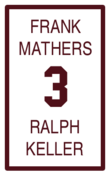 | 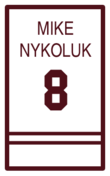 | 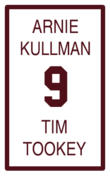 | 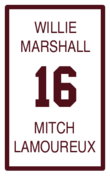 |
| Frank Mathers Defenseman 1956–62 Head coach 1956-73 General manager 1973-91 | Mike Nykoluk Center 1958–72 | Arnie Kullman Center 1948–60 | Willie Marshall Center 1956–63 |
| Ralph Keller Defenseman 1963–74 | Tim Tookey Center 1980–81 1985–87 1989–95 | Mitch Lamoureux Center 1986–89 1993–95 1997–99 |
Team captains
- Mike Nykoluk, 1967–1972
- Brett Clark, 2004–2005
- Boyd Kane, 2005–2006
- Lawrence Nycholat, Dean Arsene, Alexandre Giroux (co-captains), 2006–2007
- Quintin Laing; Dean Arsene 2007–2008
- Bryan Helmer, 2008–2010
- Andrew Joudrey, 2010–2011
- Boyd Kane, 2011–2013
- Dane Byers, 2013–2015
- Garrett Mitchell, 2015–2018
Hockey Hall of Fame members
- Frank Mathers (defenseman/coach, 1956–1962; coach, 1962–73; general manager/president, 1973–1991), enshrined 1992 (builder)[15]
- Ralph "Cooney" Weiland (coach, 1941–1945), enshrined 1971 (player)
AHL Hall of Famers
- Willie Marshall, C, 1956–63, Elected 2006
- Frank Mathers, D, 1956–62; Coach, 1956–73 and 1984–85; President/GM 1973–91. Elected 2006
- Mike Nykoluk, C, 1958–72, Elected 2007
- Gilles Mayer, G, 1956–59, Elected 2007
- Tim Tookey, C, 1980–81, 1985–87, and 1989–95, Elected 2008
- Bruce Boudreau, Coach, 2005–07, Elected 2009
- Mitch Lamoureux, C, 1986–89, 1993–95/, and 1997–99, Elected 2011
- John Paddock Coach, 1985–89, Elected 2011
- John Stevens, D, 1986–90, Elected 2012
- Frederic Cassivi, G 1999–02 and 2005–08, Elected 2015
- Bryan Helmer, D, 2008–10, Elected 2017
- Doug Yingst, Executive, 1982–2016, Elected 2017
- Don Biggs, C, 1987–90, Elected 2018
Individual award winners
Les Cunningham Award (league MVP)
- Chris Bourque: 2015–16
- Keith Aucoin: 2009–10
- Alexandre Giroux: 2008–09
- Jean-Francois Labbe: 1996–97
- Tim Tookey: 1986–87
- Mike Nykoluk: 1966–67
- George Sullivan: 1953–54
John B. Sollenberger Trophy (leading point scorer)
- Chris Bourque: 2011–12, 2015–16
- Keith Aucoin: 2009–10
- Alexandre Giroux: 2008–09
- Christian Matte: 1999–00
- Tim Tookey: 1986–87
- Mark Lofthouse: 1980–81
- Jean-Guy Gratton: 1975–76
- Jeannot Gilbert: 1968–69
- Willie Marshall: 1957–58
- George Sullivan*: 1953–54
(* = The award was known as the Carl Liscombe Trophy until 1954–55)
Jack A Butterfield Trophy (playoffs MVP)
- Chris Bourque: 2009–10
- Michal Neuvirth: 2008–09
- Frederic Cassivi: 2005–06
- Mike McHugh: 1996–97
- Wendell Young: 1987–88
- Tim Tookey: 1985–86
Willie Marshall Award (leading goal scorer)
Dudley "Red" Garrett Memorial Award (rookie of the year)
Eddie Shore Award (best defensemen)
- Dave Fenyves: 1987–88, 1988–89
- Marc Reaume: 1962–63
Aldege "Baz" Bastien Memorial Award (best goaltender)
Hap Holmes Memorial Award (goalies with lowest goals against avg)
Louis A. R. Pieri Memorial Award (coach of the year)
- John Paddock: 1987–88 (shared award with Mike Milbury)
- Doug Gibson: 1979–80
- Chuck Hamilton: 1975–76
- Frank Mathers: 1968–69
Fred T. Hunt Memorial Award (sportsmanship, determination and dedication to hockey)
AHL First Team All-Star
- Chris Bourque: 2011–12, 2015–16
- Alexandre Giroux: 2008–09, 2009–10
- Keith Aucoin: 2008–09, 2009–10, 2011–12
- Eric Perrin: 2003–04
- Serge Aubin: 1999–00
- Christian Matte: 1999–00
- Blair Atcheynum: 1996–97
- Jean-Francois Labbe: 1996–97
- Brian Dobbin: 1988–89
- Dave Fenyves: 1987–88, 1988–89
- Wendell Young: 1987–88
- Tim Tookey: 1986–87
- Ron Hextall: 1985–86
- Kevin McCarthy: 1985–86
- Mark Lofthouse: 1980–81
- Jean-Guy Gratton: 1975–76
- Jeannot Gilbert: 1968–69
- Michel Harvey: 1968–69
- Ralph Keller: 1968–69
- Mike Nykoluk: 1967–68
- Roger DeJordy: 1966–67
- Andre Gill: 1966–67
- Marc Reaume: 1962–63
- Dunc Fisher: 1957–58
- Willie Marshall: 1957–58
- Red Sullivan: 1953–54
- Joe Bell: 1945–46
- Nick Damore: 1943–44, 1944–45, 1945–46
- Gaston Gauthier: 1943–44
- Hank Lauzon: 1943–44
- Bill Moe: 1943–44
- Wally Kilrea: 1942–43
- Roger Jenkins: 1942–43
- Harry Frost: 1940–41, 1941–42, 1942–43
- Walter Kalbfleisch: 1938–39, 1939–40
AHL Second Team All-Star
- Aaron Ness: 2018–19
- Travis Boyd: 2016–17
- Jeff Taffe: 2012–13
- Keith Aucoin: 2010–11
- Andrew Gordon: 2009–10
- Mike Gaul: 1999–00
- Pascal Trepanier: 1996–97
- Jim Montgomery: 1995–96
- Bob Wilkie: 1993–94
- Tim Tookey: 1985–86, 1991–92
- Brian Dobbin: 1989–90
- Ross Fitzpatrick: 1985–86, 1989–90
- Dave Parro: 1982–83
- Rollie Boutin: 1980–81
- Tony Cassolato: 1980–81, 1982–83
- Greg Theberge: 1980–81
- Bob Bilodeau: 1977–78, 1978–79
- Don Edwards: 1975–76
- Duane Rupp: 1973–74
- Ralph Keller: 1972–73
- Stan Gilbertson: 1970–71
- Bob Leiter: 1970–71
- Roger DeJordy: 1967–68
- Mike Nykoluk: 1966–67
- Wayne Rivers: 1966–67
- Gene Ubriaco: 1965–66
- Willie Marshall: 1961–62
- Howie Yanosik: 1960–61
- Frank Mathers: 1957–58
- Bob Perreault: 1957–58, 1958–59, 1961–62
- Larry Zeidel: 1958–59
- Dick Gamble: 1954–55
- Murray Henderson: 1954–55
- Lorne Ferguson: 1953–54
- Dunc Fisher: 1953–54, 1954–55, 1955–56, 1956–57
- Harvey Bennett: 1946–47
- Norm Larson: 1945–46
- Billy Gooden: 1944–45
- Hank Lauzon: 1942–43
- Bob Goldham: 1941–42
- Alfie Moore: 1938–39
Head coaches
Asterisk (*) denotes number of Calder Cups won
- Herb Mitchell, 1938–1941
- Ralph Weiland, 1941–1945
- Don Penniston, 1945–1950*
- Johnny Crawford, 1950–1952
- Murray Henderson, 1952–1956
- Frank Mathers, 1956–1973***
- Chuck Hamilton, 1973–1979*
- Fred Stanfield, 1979
- Gary Green/Doug Gibson, 1979–80*
- Bryan Murray, 1980–81/1982
- Gary Inness, 1981/1982–1984/1985
- Frank Mathers/Bill Barber, 1984–85
- John Paddock, 1985–1989*
- Kevin McCarthy, 1989–90
- Mike Eaves, 1990–1993
- Jay Leach, 1993–1995
- Bill Barber, 1995–96
- Bob Hartley, 1996–1998*
- Mike Foligno, 1998–2003
- Paul Fixter, 2003–2005
- Bruce Boudreau, 2005–2007*
- Bob Woods, 2007–2009*
- Mark French, 2009–2013*
- Mike Haviland, 2013–14
- Troy Mann, 2014–2018[16]
- Spencer Carbery, 2018–present[17]
References
- Cooper, Bruce C. "1936-2002: HersheyPark Arena's Sixty-Six Years as Home to Hershey Bears Hockey "A Farewell to HersheyPark Arena..." Special game program for the last Hershey Bears' regular season game at HersheyPark Arena (Philadelphia Phantoms at Hershey Bears). Hershey, PA: The Hershey Bears Hockey Club, April 7, 2002
- Cooper, Bruce C. "A 60th Anniversary History of the AHL Hershey Bears: 1938–1998" Published as a 12-page "60th Anniversary" magazine format booklet by the Hershey Bears Hockey Club, October, 1998
- Chaimovitch, Jason (ed). "2014-15 American Hockey League Official Guide & Record Book" Springfield, MA: The American Hockey League, 2014
- "The Hershey Entertainment and Resorts Company" Hershey Community Archives, HersheyArchives.org
- Leone 2003, p. Introduction.
- Hershey Bears >. Hersheypa.com (1969-12-31). Retrieved on 2013-07-23.
- The American Hockey League | Home Page. TheAHL.com. Retrieved on 2013-07-23.
- Adirondack rallies to end the Hershey Bears' home winning streak at 24 games | PennLive.com. Blog.pennlive.com. Retrieved on 2013-07-23.
- Bears lose Outdoor Classic - abc27 WHTM Archived 2013-01-25 at the Wayback Machine. Abc27.com. Retrieved on 2013-07-23.
- "2015-16 American Hockey League First and Second All-Star Teams Named". OurSportsCentral.com. April 7, 2016.
- "2016-17 American Hockey League First and Second All-Star Teams Named". OurSportsCentral.com. April 6, 2017.
- "Coco the Bear". Hershey Bears. Archived from the original on March 4, 2007. Retrieved April 18, 2007.
- "Hershey Bears – Team roster". Hershey Bears. Retrieved May 6, 2019.
- "Hershey Bears Elite Prospects". Elite Prospects. Retrieved February 12, 2019.
- "Thanks for the memories". hockeyscoop.net. February 27, 2005. Retrieved February 27, 2005.
- "Capitals Announce Contracts of Mann, Murphy Will Not be Renewed". OurSportsCentral.com. April 25, 2018.
- "Spencer Carbery Named Head Coach of the Hershey Bears". OurSportsCentral.com. June 26, 2018.
Bibliography
- Leone, Tim (2003). The Hershey Bears: Sweet Seasons (Images of Sports). Arcadia. ISBN 978-0738513331.CS1 maint: ref=harv (link)
External links
| Wikimedia Commons has media related to Hershey Bears. |
- Hershey Bears (official site)
- "A 60th Anniversary History of the AHL Hershey Bears: 1938–1998"
- "1936–2002: HersheyPark Arena's Sixty-Six Years as Home to Hershey Bears Hockey"
- "The 1938–39 Philadelphia-Hershey Hockey Wars"
- The Internet Hockey Database – Hershey Bears (AHL)
- The Internet Hockey Database – Hershey Bears (IAHL)
